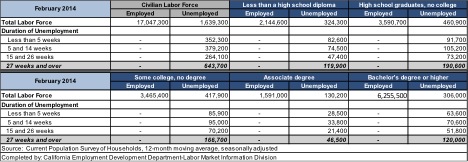During the Great Recession the number of long term unemployed in California—defined as those unemployed at least 27 weeks—increased at a significantly more rapid pace than the unemployed overall. In March 2007, prior to the Great Recession, 145,000 Californians were unemployed at least 27 weeks, constituting 16.8% of the unemployed. By March 2010, the long term unemployed had climbed to 843,000 Californians, and they constituted over 39% of the total unemployed.
The number of long term unemployed Californians has dropped in the past few years in line with the general drop in the unemployed. However, according to the most recent data compiled by Mr. Brandon Hooker of EDD’s Labor Market Information Division (chart below), in February of this year the long term unemployed, totaling 643,700 Californians, continued to constitute 39% of the total unemployed—well above pre-Great Recession levels.
 This rise in long term unemployed has not escaped California’s workforce system. In the past few years, assisting the long term unemployed has been among the top priorities of EDD, the California Workforce Investment Board (CWIB), and local WIBs. In turn, a range of employment programs have been funded.
This rise in long term unemployed has not escaped California’s workforce system. In the past few years, assisting the long term unemployed has been among the top priorities of EDD, the California Workforce Investment Board (CWIB), and local WIBs. In turn, a range of employment programs have been funded.
Some of these programs seek to retrain the long term unemployed for new occupations. The engineering pathway program by the workforce intermediary Growth Sector is an example: a two year training with Lawrence Livermore National Laboratory, NASA Ames, and other major engineering employers to assist long term unemployed workers, especially Veterans, to obtain a two-year degree in engineering technology linked to a paid internship.
Most of the programs, though, are aimed at immediate job placement. This is due both to the relatively high education level of the long term unemployed (as indicated in Mr. Hooker’s chart above), and the financial and psychologically drives for immediate placement.
As our Department of Labor ETA Administrator Ms. Virginia Hamilton notes, the best practices for these direct placement programs for the long term unemployed include a number of supportive services: financial management, mentoring, peer mutual support. They also may include financial incentives to employers, such as on-the-job training (OJT) funds and paid internships.
The elephant in the room encountered by placement programs utilizing OJTs or paid internships is that few employers are willing to participate, even with very generous subsidies. Ms. Kris Stadelman NOVA WIB Director points out that employers in the Silicon Valley have been very reluctant to utilize either OJTs or paid internships, especially the tech employers. “They think that if an employee is valuable, money is not an issue, and that no amount of subsidy is worthwhile for an employee that is not the right employee.” Mr. John Colborn of the Aspen Institute adds that this is not limited to Silicon Valley or California: workforce programs in other states are facing the same difficulty with their long term unemployed strategies.
The paid internship, in particular, has a lot of advantages as a workforce strategy for the long term unemployed. It helps to overcome the strong reluctance of California employers today to make any formal hire, and incur the costs and liability of employment. It enables the long term unemployed to get over the biggest hurdle today facing all workers—getting in the door.
Going forward, if paid internships are going to succeed on any scale for the long term unemployed, local WIBs and workforce intermediaries will need to experiment with their design. It may be that the internships need to be under a separate employer-of-record, or be linked to a tech sorting mechanism, or have other features that overcome employer reluctance for any increased hiring.
The long term unemployed in California face the same gig economy—the economy of projects rather than full time employment—that we all face, as well as the same increased competition for each job opening. As with other workforce strategies today, a lot more effort and creativity is needed to achieve employment for the long term unemployment than was necessary in previous decades.

